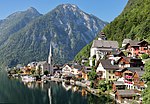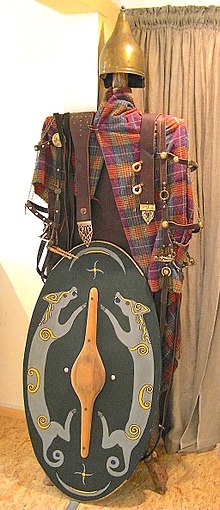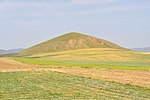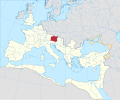The Hallstatt culture was the predominant Western and Central European archaeological culture of the Late Bronze Age (Hallstatt A, Hallstatt B) from the...
77 KB (8,507 words) - 04:56, 7 July 2024
Salzburg and Graz. Hallstatt is known for its production of salt, dating back to prehistoric times, and gave its name to the Hallstatt culture, the archaeological...
22 KB (2,023 words) - 04:54, 7 July 2024
Roman conquest in the 1st century BC), succeeding the early Iron Age Hallstatt culture without any definite cultural break, under considerable Mediterranean...
45 KB (4,471 words) - 00:51, 29 June 2024
part of the Pre-Roman Iron Age. The culture evolved out of the Nordic Bronze Age. 6th century BC, Jastorf A (Hallstatt D) 5th century BC, Jastorf B (La Tène...
8 KB (903 words) - 18:45, 11 June 2024
Celts (redirect from Ancient Celtic culture)
Age Hallstatt culture which followed it (c. 1200–500 BC), named for the rich grave finds in Hallstatt, Austria, and with the following La Tène culture (c...
147 KB (16,662 words) - 00:12, 8 July 2024
Urnfield culture followed the Tumulus culture and was succeeded by the Hallstatt culture. Some linguists and archaeologists have associated this culture with...
99 KB (10,748 words) - 04:54, 28 June 2024
information regarding the material culture of the Celts, especially that of the La Tène culture and Hallstatt culture. However, the significance of these...
82 KB (9,432 words) - 03:32, 8 June 2024
Lusatian culture) to V of the Northern European chronological scheme. It has been associated or closely linked with the Nordic Bronze Age. Hallstatt influences...
13 KB (1,261 words) - 21:05, 3 July 2024
to be Kerma Kush and the A-Group culture of ancient Nubia. While the stele-circled burial mounds of C-Group culture of Nubia are regarded as precursors...
98 KB (10,848 words) - 00:08, 3 July 2024
culture" specifically refers to the South German variant of the Bronze Age. In the table, Ha designates Hallstatt. Archaeological horizons Hallstatt A–B...
23 KB (2,064 words) - 10:43, 1 July 2024
particular archaeological culture or other typological unit, which is often named after it. For example, discoveries at La Tène and Hallstatt led scholars to divide...
4 KB (428 words) - 06:34, 2 March 2024
grouped with related Bosut culture, into the Bosut-Basarabi complex. The Basarabi culture is related to the Hallstatt culture of the Iron Age period that...
4 KB (378 words) - 04:07, 3 April 2024
Central Europe the Urnfield culture had already given way to the Hallstatt culture. In north Italy the Villanovan culture is regarded as the start of...
32 KB (4,196 words) - 12:54, 8 July 2024
Age date near to the mines, which have made Hallstatt the type site for the important Hallstatt culture. The museum is close to the Hallstättersee, below...
11 KB (948 words) - 08:09, 25 December 2022
Minoan civilization (redirect from Minoan culture)
The Minoan civilization was a Bronze Age culture which was centered on the island of Crete. Known for its monumental architecture and energetic art, it...
116 KB (13,771 words) - 00:06, 6 July 2024
Salzkammergut (redirect from Hallstatt-Dachstein / Salzkammergut Cultural Landscape)
in use at least since the days of the Celtic Hallstatt culture, centered at the mining town of Hallstatt. These operations were continued by the Romans...
15 KB (1,563 words) - 17:11, 6 April 2024
Cycladic culture (also known as Cycladic civilisation or, chronologically, as Cycladic chronology) was a Bronze Age culture (c. 3100–c. 1000 BC) found...
14 KB (1,538 words) - 13:54, 29 April 2024
Catacomb culture. In addition to the Yamnaya culture, the Catacomb culture displays links with the earlier Sredny Stog culture, the Afanasievo culture and...
28 KB (3,366 words) - 16:37, 29 June 2024
Sigynnae (section On the Hallstatt culture)
peoples of the Hallstatt culture, with a demarcation existing between the western parts of the Pannonian Basin inhabited by the sedentary Hallstatt farmers and...
35 KB (4,407 words) - 05:45, 22 June 2024
The Ulaanzuukh culture, also Ulaanzuukh-Tevsh culture (Ch:乌兰朱和文化, c. 1450-1000 BCE), is an archaeological culture of the Late Bronze Age eastern Mongolia...
11 KB (1,186 words) - 09:55, 23 June 2024
matching can yield useful calendar dates. The plateau is named after the Hallstatt culture period in central Europe with which it coincides. Wiggle matching...
3 KB (403 words) - 15:52, 4 March 2023
The Karasuk culture (Russian: Карасукская культура, romanized: Karasukskaya kul'tura) describes a group of late Bronze Age societies who ranged from the...
30 KB (3,264 words) - 12:19, 22 January 2024
Around 800 BC, the region was inhabited mostly by the people of the Hallstatt culture. Around 450 BC, they merged with the people of other areas in the...
15 KB (1,548 words) - 22:27, 8 November 2023
Proto-Villanovan culture to the Central European Urnfield culture and Celtic Hallstatt culture that succeeded it. It is not possible to tell these apart in their...
6 KB (600 words) - 03:42, 5 July 2024
the Hallstatt culture – as supported by the known homelands of La Tène culture. The culture came to an end with the advent of the Hallstatt culture. Atlantic...
6 KB (715 words) - 12:06, 5 March 2024
the Iron Age in Central Europe, with the spread of the Proto-Celtic Hallstatt culture, and the Proto-Celtic language. The major Olmec site of San Lorenzo...
8 KB (953 words) - 00:29, 30 May 2024
the Hallstatt culture, this amber found its way to the Villanovan culture. In return, the Germanic peoples imported salt from the Hallstatt culture. The...
124 KB (15,692 words) - 16:31, 7 May 2024
Timber-grave culture, was a Late Bronze Age 1900–1200 BC culture in the eastern part of the Pontic–Caspian steppe. It is a successor of the Yamna culture, the...
16 KB (1,622 words) - 21:21, 22 March 2024
Gold appliqués, Urnfield culture, c. 1200 BC. Bronze breastplate, Hallstatt culture, 600 BC Vače Situla, Hallstatt culture, 5th century BC Princely warrior...
81 KB (9,590 words) - 07:43, 4 July 2024
tombs to a pre-Roman culture of the early Iron Age, with a likely Celtic substratum given the similarities with the Hallstatt culture. He made several trips...
20 KB (2,182 words) - 19:29, 6 July 2024























